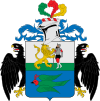Department of Huánuco facts for kids
Quick facts for kids
Department of Huánuco
|
|||
|---|---|---|---|

The Huayhuash mountain range with Yerupajá, one of the highest peaks of Peru
|
|||
|
|||

Location of the Department of Huánuco in Peru
|
|||
| Country | Peru | ||
| Subdivisions | 11 provinces and 76 districts | ||
| Largest city | Huánuco | ||
| Capital | Huánuco | ||
| Area | |||
| • Total | 36,848.85 km2 (14,227.42 sq mi) | ||
| Highest elevation | 3,839 m (12,595 ft) | ||
| Lowest elevation | 167 m (548 ft) | ||
| Population
(2005 Census)
|
|||
| • Total | 730,871 | ||
| • Density | 19.834296/km2 (51.37059/sq mi) | ||
| UBIGEO |
10
|
||
| Dialing code | 062 | ||
| ISO 3166 code | PE-HUC | ||
| Principal resources | – | ||
| Poverty rate | 78.9% | ||
| Percentage of Peru's GDP | 1% | ||
| Website | www.regionhuanuco.gob.pe | ||
Huánuco is a region in central Peru. It's like a large state or province. It shares borders with other regions such as La Libertad, San Martín, and Ucayali. The capital city of this region is also called Huánuco.
Huánuco has a varied landscape. It includes parts of the Sierra (mountain range) and high jungle areas. Its location gives it a mild climate all year round. The average temperature is about 20 degrees Celsius (68 degrees Fahrenheit).
This region is very important for its history and rich land. People have lived here for a very long time. For example, "El Hombre de Lauricocha" (the Man of Lauricocha) lived here around 10,000 BC. Also, at Kotosh, scientists found signs of one of the oldest settlements in the Americas, dating back to 4200 BC.
Many different groups of people lived in this region long ago. After some resistance, they became part of the Inca empire. Huánuco then became a key stop on the route between Cusco and Cajamarca.
In the early 1800s, Huánuco was one of the first cities to support Peru's independence. People here took an oath for freedom on December 15, 1820. This happened after several uprisings in nearby towns like Huamalíes, Huallanca, and Ambo.
Contents
Political Divisions of Huánuco
The Huánuco region is divided into 11 main areas called provinces. These provinces are further divided into 75 smaller areas called districts.
Here are the provinces and their capital cities:
- Ambo (capital: Ambo)
- Dos de Mayo (capital: La Unión)
- Huacaybamba (capital: Huacaybamba)
- Huamalíes (capital: Llata)
- Huánuco (capital: Huánuco)
- Lauricocha (capital: Jesús)
- Leoncio Prado (capital: Tingo María)
- Marañón (capital: Huacrachuco)
- Pachitea (capital: Panao)
- Puerto Inca (capital: Puerto Inca)
- Yarowilca (capital: Chavinillo)
Languages Spoken in Huánuco
Most people in Huánuco speak Spanish. However, many also speak Quechua, an ancient native language of Peru. The type of Quechua spoken here is called Huánuco Quechua.
The table below shows which language people learned first in each province of Huánuco, according to the 2007 Peru Census:
| Province | Quechua | Aymara | Asháninka | Another native language | Spanish | Foreign language | Deaf or mute | Total |
|---|---|---|---|---|---|---|---|---|
| Ambo | 13,141 | 30 | 9 | 5 | 38,840 | 2 | 86 | 52,113 |
| Dos de Mayo | 17,399 | 20 | 5 | 11 | 26,102 | 6 | 91 | 43,634 |
| Huacaybamba | 14,920 | 19 | 2 | 2 | 3,869 | 1 | 106 | 18,919 |
| Huamalies | 32,873 | 44 | 6 | 6 | 28,511 | 4 | 226 | 61,670 |
| Huanuco | 60,281 | 177 | 73 | 62 | 192,886 | 54 | 369 | 253,902 |
| Leoncio Prado | 8,990 | 78 | 30 | 82 | 99,915 | 19 | 178 | 109,292 |
| Marañon | 6,073 | 8 | 4 | 7 | 18,367 | - | 82 | 24,541 |
| Pachitea | 26,229 | 56 | 9 | 14 | 29,415 | - | 107 | 55,830 |
| Puerto Inca | 1,582 | 81 | 545 | 731 | 25,541 | 2 | 59 | 28,541 |
| Lauricocha | 3,415 | 17 | 4 | 8 | 29,481 | - | 23 | 32,948 |
| Yarowilca | 18,308 | 30 | 6 | 2 | 11,633 | - | 49 | 30,028 |
| Total | 203,211 | 560 | 693 | 930 | 504,560 | 88 | 1,376 | 711,418 |
| % | 28.56 | 0.08 | 0.10 | 0.13 | 70.92 | 0.01 | 0.19 | 100.00 |
Cool Places to Visit in Huánuco
Huánuco has many interesting places to explore, including:
- Awkillu Waqra
- Awkimarka
- El Sira Communal Reserve
- Qillqay Mach'ay
- Huayhuash mountain range
See also
 In Spanish: Departamento de Huánuco para niños
In Spanish: Departamento de Huánuco para niños





